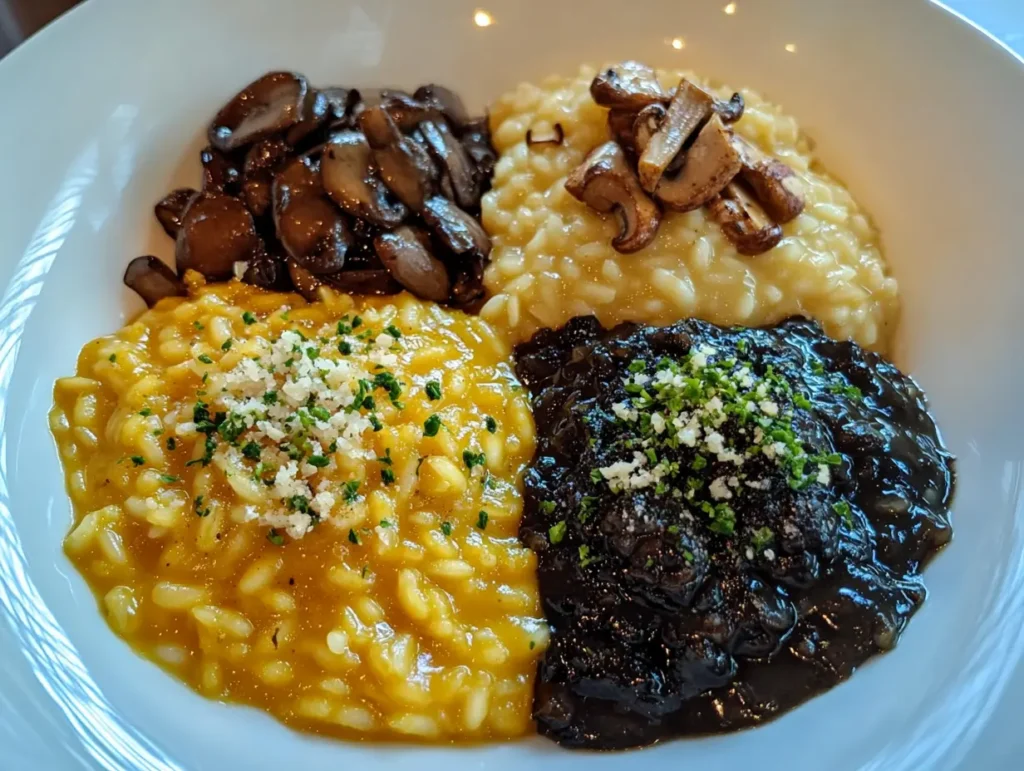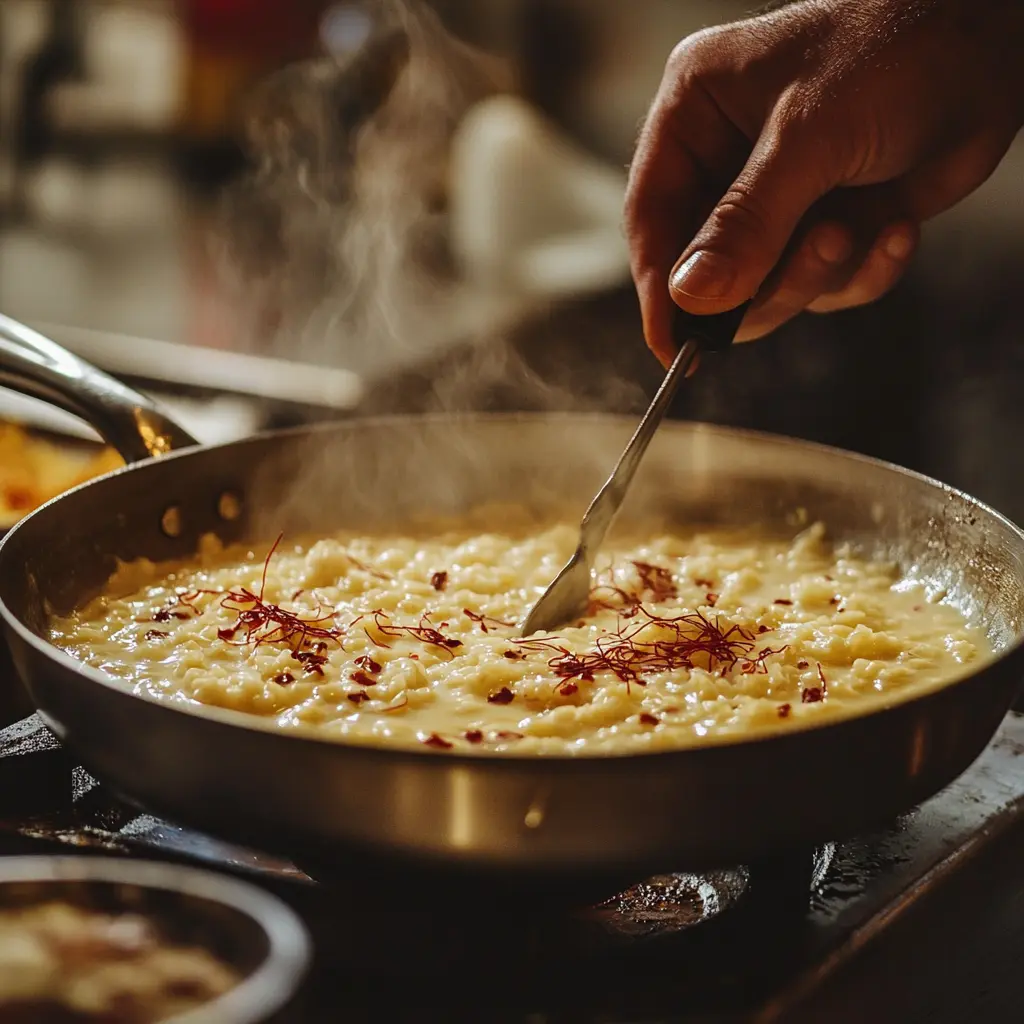Risotto is much more than just a dish in Italy—it’s the answer to the question, ‘What is the famous risotto in Italy?’ It’s a culinary masterpiece, a symbol of comfort, and a testament to the country’s rich cultural heritage. But when you think of Italy, pasta and pizza often steal the limelight, right? Well, risotto deserves its moment in the spotlight too! So, what exactly is the famous risotto in Italy, and why does it have such a special place in Italian kitchens? Let’s dive in and explore.
Have you ever heard someone describe risotto as “Italian soul food”? That’s because it truly is. Risotto is a creamy rice dish that feels like a warm hug in a bowl. It’s not just a meal; it’s an experience, blending simple ingredients with expert techniques to create something magical.
But here’s the kicker: not all risottos are created equal. Some have gained international fame, with one standing out as the most iconic—the renowned Risotto alla Milanese.
Table of Contents
The Cultural Significance of Risotto in Italian Cuisine
A Brief History of Risotto
Risotto didn’t just pop up overnight. Its roots go back centuries, offering rich history and context to answer the question, ‘What is the famous risotto in Italy?’ Rice was first introduced to Italy by Arab traders in the Middle Ages. Northern Italy’s humid climate proved perfect for growing rice, and before long, Italians began crafting what would become one of their most beloved dishes.
But here’s where it gets interesting: the dish we know today as risotto started gaining fame in Milan, where saffron became a star ingredient. This golden spice elevated risotto to a whole new level of elegance and luxury.
Why Risotto Holds a Special Place in Italian Hearts
Think of risotto as the culinary equivalent of a beautifully composed symphony. It’s not fast food—it’s slow, deliberate, and requires patience. Italians value this process because it represents their passion for quality over speed. Plus, the dish is incredibly versatile, adapting to local ingredients and personal tastes.
What Makes a Risotto Famous?
Regional Variations Across Italy
Did you know that almost every region in Italy has its own version of risotto? If you’re exploring regional variations to find the answer to ‘What is the famous risotto in Italy?’ you’ll discover a variety of creamy seafood risottos in coastal areas and earthy mushroom risottos in the mountains. Each adapts beautifully to local flavors. If you love Italian cuisine, don’t miss this guide on Green Spaghetti, another unique and vibrant pasta dish rooted in Italian traditions.
However, the crown jewel is Risotto alla Milanese, often called the “queen of all risottos.” Its unique blend of creamy rice, butter, Parmesan, and saffron creates a luxurious dish that’s both simple and extravagant.
Key Ingredients That Define a Perfect Risotto
Here’s the secret to a truly great risotto: it all starts with the rice. To truly understand ‘What is the famous risotto in Italy?’ you need to know the key ingredients. Discover the secret ingredient in risotto that can elevate your dish to new heights. Varieties like Arborio, Carnaroli, and Vialone Nano are the holy trinity of risotto-making. These short-grain rices are perfect for absorbing liquid while releasing starch, giving risotto its signature creamy texture.
Add to that a good broth, quality butter, fresh Parmesan, and—if you’re making Risotto alla Milanese—a pinch of saffron, and you’ve got the recipe for success.
Exploring the Most Famous Risotto in Italy: Risotto alla Milanese
The Origin of Risotto alla Milanese
If you’re still wondering, ‘What is the famous risotto in Italy?’ legend points to Risotto alla Milanese, believed to have been born during the construction of the Milan Cathedral in the 16th century. A worker supposedly added saffron—used for coloring stained glass—to his rice for a splash of flavor. Whether that story is true or not, one thing’s certain: this dish has become an enduring symbol of Milan.
“Risotto alla Milanese is not just a recipe; it’s a legacy passed down through generations.”
Key Ingredients of Risotto alla Milanese
Here’s a quick snapshot of what you’ll need to make this iconic dish:
| Ingredient | Quantity |
|---|---|
| Arborio or Carnaroli Rice | 1 cup |
| Saffron Threads | A pinch |
| Chicken or Beef Broth | 4 cups |
| Butter | 3 tablespoons |
| Parmesan Cheese | ½ cup grated |
| Onion | 1, finely chopped |
| White Wine | ½ cup |
| Salt and Pepper | To taste |
The Distinctive Flavor of Saffron in Risotto alla Milanese
Let’s talk about saffron. Known as the “gold of spices,” it’s what makes Risotto alla Milanese so special. This spice not only gives the dish its vibrant golden hue but also adds a subtle floral and earthy flavor.
Fun fact: Saffron is one of the most expensive spices in the world. But don’t worry—you only need a tiny pinch to transform your risotto into something extraordinary.
Other Popular Risotto Varieties Across Italy

While Risotto alla Milanese answers the question, ‘What is the famous risotto in Italy?’ the country also offers plenty of other delightful risotto options. Each one showcases local ingredients and regional traditions.
Risotto al Tartufo (Truffle Risotto)
Truffles are a delicacy, and when combined with risotto, they create a dish that’s rich, earthy, and indulgent. This is a must-try for any food lover.
Risotto ai Funghi (Mushroom Risotto)
Packed with the umami goodness of fresh mushrooms, this version is a cozy, comforting classic. Perfect for a chilly evening!
Risotto al Nero di Seppia (Squid Ink Risotto)
Looking for something bold and adventurous? This black-hued risotto, flavored with squid ink, is as striking as it is delicious.
Risotto alle Verdure (Vegetable Risotto)
For a lighter, vegetarian-friendly option, vegetable risotto is a great choice. Seasonal veggies make this dish fresh and vibrant.
Common Problems When Making Risotto and Their Solutions
Risotto may seem intimidating, but don’t worry—I’ve got your back. Let’s tackle some common problems you might face.
Problem: Risotto Too Sticky or Mushy
Ever ended up with a pot of glue instead of risotto? That’s usually because of overcooking or using the wrong rice.
Solution: Stick to high-quality short-grain rice like Arborio, Carnaroli, or Vialone Nano, and keep an eye on your cooking time.
Problem: Risotto Lacks Flavor
A bland risotto is a sad risotto. The culprit? Weak broth or skimping on the seasonings.
Solution: Use a rich, flavorful broth—whether it’s chicken, beef, or veggie—and don’t be shy with the Parmesan.
Problem: Risotto Takes Too Long to Cook
Risotto is a labor of love, but it shouldn’t feel like running a marathon.
Solution: Maintain a steady simmer in your broth and stir regularly, but not excessively. This keeps the cooking process smooth and efficient.
Where in Italy Can You Find the Best Risotto?
When it comes to experiencing risotto at its finest, Italy offers a culinary map dotted with unforgettable destinations. Each region puts its own spin on the dish, reflecting local ingredients, traditions, and flavors. So, where should you go to find the best risotto in Italy? Let’s take a gastronomic tour.
Lombardy: The Home of Risotto alla Milanese
If there’s one place to start, it’s Lombardy. The region’s rich soils are ideal for rice cultivation, and it’s no surprise that Risotto alla Milanese calls this region home. Milan, the capital, boasts countless restaurants and trattorias serving this golden delight.
Locals swear by pairing Risotto alla Milanese with Osso Buco, a braised veal shank, for the ultimate Milanese experience. Imagine the creamy rice infused with saffron, complemented by the hearty, meaty flavors of Osso Buco—it’s a match made in culinary heaven.
Veneto: Risotto with a Coastal Twist
In the Veneto region, risotto takes on a seafood-forward approach, thanks to its proximity to the Adriatic Sea. Cities like Venice serve up Risotto al Nero di Seppia, a bold and briny dish featuring squid ink. Its jet-black appearance might surprise you at first, but one bite will have you hooked.
Veneto is also known for Risotto all’Amarone, a unique version made with Amarone wine. This dish combines the creamy texture of risotto with the rich, velvety taste of red wine—an absolute treat for wine lovers.
Piedmont: Truffles and Risotto
Head to Piedmont, and you’ll discover a risotto lover’s paradise. This region is famous for its white truffles, a rare and aromatic delicacy that pairs beautifully with risotto. Risotto al Tartufo Bianco, or white truffle risotto, is the star of many fine dining menus here.
Autumn is the best time to visit Piedmont, as it’s truffle season. The region comes alive with truffle festivals, where you can savor freshly shaved truffles over a steaming plate of risotto.
What Do Italians Call Risotto? Understanding the Terminology
To truly appreciate risotto, it helps to understand how Italians view and talk about this dish. For them, it’s not just food—it’s a cultural emblem.
The Definition of Risotto in Italian Cuisine
In Italian, “risotto” simply translates to “little rice.” But don’t let the name fool you—it’s anything but ordinary. Italians use the term to describe a specific method of cooking rice where broth is gradually added and absorbed, creating a creamy consistency.
It’s worth noting that risotto isn’t just one dish but a category of dishes. Each type of risotto has its own name, often reflecting its main ingredient, like Risotto ai Funghi (mushroom risotto) or Risotto alla Pescatora (seafood risotto).
Local Terms and Variations You Might Encounter
In some regions, risotto might be referred to with colloquial names or slight variations. For example:
- In Milan, Risotto alla Milanese is affectionately called “riso giallo” (yellow rice) because of its saffron hue.
- In Piedmont, locals often emphasize the specific rice variety, like riso Carnaroli, underscoring the importance of quality ingredients.
What Does Risotto alla Milanese Taste Like? A Flavor Profile
If you’ve never tried Risotto alla Milanese, you might be wondering: what does it taste like? Well, imagine the most luxurious combination of flavors and textures.
The Richness of Butter and Parmesan
The first thing you’ll notice is the creamy richness, thanks to the generous use of butter and Parmesan cheese. These ingredients melt into the rice, creating a velvety texture that coats your palate with every bite. It’s like a warm embrace—simple, yet deeply satisfying.
The Aromatic Elegance of Saffron
Then comes the star of the show: saffron. This spice adds a subtle floral aroma and a touch of earthiness. It doesn’t overpower but instead enhances the dish, making each bite a delicate balance of flavors.
“Eating Risotto alla Milanese feels like tasting the sun, with its golden color and warm, inviting flavor.”
How to Make Risotto alla Milanese at Home: A Step-by-Step Guide

Are you ready to bring the magic of Milan into your kitchen? Making Risotto alla Milanese might seem intimidating, but with a little patience and the right technique, you can recreate this iconic dish at home.
Ingredients You Will Need
Here’s a quick checklist of ingredients for your Risotto alla Milanese:
| Ingredient | Quantity |
|---|---|
| Arborio or Carnaroli Rice | 1 cup |
| Saffron Threads | A pinch |
| Chicken or Beef Broth | 4 cups |
| Butter | 3 tablespoons |
| Parmesan Cheese | ½ cup grated |
| Onion | 1, finely chopped |
| White Wine | ½ cup |
| Salt and Pepper | To taste |
Step-by-Step Cooking Instructions
- Prepare the Saffron Infusion:
- Heat a small amount of broth and add the saffron threads. Let it steep for a few minutes to release its color and flavor.
- Sauté the Onion:
- In a large pan, melt 2 tablespoons of butter over medium heat. Add the finely chopped onion and sauté until it’s translucent.
- Toast the Rice:
- Add the rice to the pan and stir it for about 2 minutes. This step ensures the grains are lightly toasted, which helps them retain their texture during cooking.
- Deglaze with Wine:
- Pour in the white wine and stir until it’s mostly absorbed. This adds a nice acidity that balances the richness of the dish.
- Add the Broth Gradually:
- Start adding the broth, one ladleful at a time, stirring constantly. Wait for the liquid to be absorbed before adding more. This process should take about 18–20 minutes.
- Incorporate the Saffron:
- About halfway through cooking, stir in the saffron-infused broth. Watch as your risotto transforms into a vibrant golden hue.
- Finish with Butter and Parmesan:
- Once the rice is al dente and the dish has a creamy consistency, remove it from the heat. Stir in the remaining butter and Parmesan cheese. Season with salt and pepper to taste.
- Serve Immediately:
- Risotto waits for no one! Serve it hot, garnished with a sprinkle of Parmesan if desired.
Tips for Perfecting Your Risotto
Want to take your risotto to the next level? Here are some pro tips:
- Choose the Right Rice: Always opt for high-starch varieties like Arborio or Carnaroli for the creamiest results.
- Keep Your Broth Warm: Adding cold broth to hot rice can disrupt the cooking process. Keep it simmering on the stove.
- Master the Art of Stirring: Stir regularly to release the rice’s starch, but don’t overdo it—you don’t want to break the grains.
FAQ Section
Risotto is a fascinating dish with a rich history and countless variations, but it can also raise plenty of questions for those new to it. Let’s clear up some common queries about this Italian classic.
What is the most famous risotto?
Without a doubt, the most famous risotto is Risotto alla Milanese. Known for its luxurious saffron-infused flavor and creamy texture, this dish is a staple in Milan and a favorite worldwide. Its vibrant golden hue makes it instantly recognizable, and its simplicity allows the quality of the ingredients to shine.
Other notable contenders include Risotto al Tartufo (truffle risotto), cherished for its earthy elegance, and Risotto ai Frutti di Mare (seafood risotto), popular in coastal regions.
Where in Italy is the best risotto?
If you’re searching for the best risotto, look no further than Lombardy, particularly Milan. The city’s restaurants and trattorias serve Risotto alla Milanese as a specialty, often paired with regional dishes like Osso Buco.
That said, regions like Veneto, with its seafood variations, and Piedmont, celebrated for its truffle-infused risottos, also offer top-tier experiences. Each region brings its own flair, making Italy a true risotto paradise.
What do Italians call risotto?
Italians simply call it “risotto,” but the name often includes a descriptor that highlights its main ingredient. For example:
- Risotto alla Milanese features saffron.
- Risotto ai Funghi spotlights mushrooms.
- Risotto al Nero di Seppia emphasizes squid ink.
This naming convention reflects Italy’s deep connection to local ingredients and regional pride.
What does Risotto alla Milanese taste like?
Risotto alla Milanese is a symphony of creamy, buttery, and savory flavors, elevated by the subtle floral notes of saffron. The Parmesan adds a nutty depth, while the rice’s al dente texture provides a satisfying bite. Imagine a dish that feels both indulgent and comforting, perfect for a cozy dinner or a special occasion.
Conclusion: Embracing the Art of Risotto
If you’ve ever asked yourself, ‘What is the famous risotto in Italy?’ remember that risotto isn’t just food—it’s an experience, a labor of love that embodies the very essence of Italian cooking. From the buttery richness of Risotto alla Milanese to the bold flavors of regional variations like truffle or seafood risottos, this dish has something for everyone.
But what truly makes risotto special is the care and patience it demands. Cooking it teaches us to slow down, savor the process, and appreciate the simple joy of transforming humble ingredients into something extraordinary.
Whether you’re planning a trip to Italy to taste authentic risotto or trying your hand at making it at home, remember this: risotto is more than a recipe—it’s a tradition, a memory, and above all, a celebration of life. 🍚✨
Risotto alla Milanese
Ingredients
Method
- Heat a small amount of broth and add the saffron threads. Let it steep for a few minutes to release its color and flavor.
- In a large pan, melt 2 tablespoons of butter over medium heat. Add the finely chopped onion and sauté until it’s translucent.
- Add the rice to the pan and stir it for about 2 minutes to lightly toast the grains.
- Pour in the white wine and stir until it’s mostly absorbed.
- Start adding the broth, one ladleful at a time, stirring constantly. Wait for the liquid to be absorbed before adding more. This process should take about 18–20 minutes.
- About halfway through cooking, stir in the saffron-infused broth.
- Once the rice is al dente and the dish has a creamy consistency, remove it from the heat. Stir in the remaining butter and Parmesan cheese. Season with salt and pepper to taste.
- Serve immediately, garnished with a sprinkle of Parmesan if desired.
